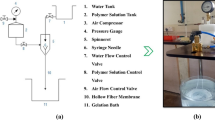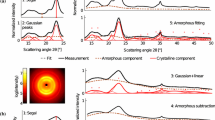Abstract
It is well known that there are two crystal types for a cellulose/water complex: Na–cellulose IV and cellulose II hydrate. The water molecules in these crystals are released with increasing temperature and the hydrated models are then transformed into cellulose II crystals. Dehydration can be observed even when the cellulose/water crystal is soaked in water. In this study, we investigated the dehydration process in Na–cellulose IV and cellulose II hydrate using molecular dynamics simulations. In both crystals, as simulation time progressed, the water molecules were gradually released from the crystal while forming hydrogen bonds with the hydroxyl groups of cellulose. Interestingly, water molecules were released from the spaces between the molecular sheets formed by hydrophobic interactions. All hydroxyl groups existed on the surface of the molecular sheets. Therefore, it is reasonable to suggest that water molecules pass between the sheets. For Na–cellulose IV, the ratio of gt conformations was high. In addition, it was observed that water molecules were in the space between O6 and O3 on each adjacent molecular sheet forming hydrogen bonds during simulation. On the other hand, the gg conformations were mainly observed in cellulose II hydrate probably because of the presence of the O6···O6 intermolecular hydrogen bond. During the simulation, the water molecules were present in the space between O2 and O3 while forming hydrogen bonds.








Similar content being viewed by others
References
Allen MP, Tildesley DJ (1987) Computer simulations of liquids. Oxford Science, Oxford
Berendsen HJC, Grigera JR, Straatsma TPJ (1987) The missing term in effective pair potentialst. Phys Chem 91:6269–6271
Brooks BR, Bruccoleri RE, Olafson BD, Swaminathan S, Karplus M (1983) CHARMM: a program for macromolecular energy, minimization, and dynamics calculations. J Comput Chem 4:187–217
Brooks BR, Brooks CL III, MacKerell AD Jr, Nilsson L, Petrella RJ, Roux B, Won Y, Archontis G, Bartels C, Boresch S, Caflisch A, Caves L, Cui Q, Dinner AR, Feig M, Fischer S, Gao J, Hodoscek M, Im W, Kuczera K, Lazaridis T, Ma J, Ovchinnikov V, Paci E, Pastor RW, Post CB, Pu JZ, Schaefer M, Tidor B, Venable RM, Woodcock HL, Wu X, Yang W, York DM, Karplus M (2009) CHARMM: the biomolecular simulation program. J Comput Chem 30:1545–1614
Darden T, York D, Pedersen L (1993) Particle mesh Ewald: an N·log(N) method for Ewald sums in large systems. J Chem Phys 98(12):10089–10092
Durell SR, Brooks BR, Ben-Naim A (1994) Solvent-induced forces between two hydrophilic groups. J Chem Phys 98:2198–2202
Fernandes AN, Thomas LH, Altaner CM, Callow P, Forsyth TV, Apperley DC, Kennedy CJ, Jarvis MC (2011) Nanostructure of cellulose microfibrils in spruce wood. Proc Natl Acad Sci 108:1195–1203
Guvench O, Greene SN, Kamath G, Brady JW, Venable RM, Pastor RW, MacKerell AD Jr (2008) Additive empirical force field for hexopyranose monosaccharides. J Comp Chem 29(15):2543–2564
Guvench O, Hatcher ER, Venable RM, Pastor RW, MacKerell AD Jr (2009) CHARMM additive all-atom force field for glycosidic linkages between hexopyranoses. J Chem Theory Comput 5(9):2353–2370
Hayashi J, Masuda S, Watanabe S (1974) Plane lattice structure in amorphous region of cellulose fibers. J Chem Soc Jap Chem Ind Chem (Nippon Kagaku Kaishi) 5:948–954
Hermans PH (1949) Degree of lateral order in various rayons as deduced from X-ray measurements. J Polym Sci 4:145–151
Hermans PH, Weidinger A (1948) Quantitative X-ray investigations on the crystallinity of cellulose fibers. J Appl Phys 19:491–506
Hermans J, Berendsen HJC, van Gunsteren WF, Postma JPM (1984) A consistent empirical potential for water-protein interactions. Biopolymers 23:1513–1518
Hoover WG (1985) Canonical dynamics: equilibrium phase-space distributions. Phys Rev A 31(3):1695–1697
Horii F, Hirai A, Kitamaru R (1983) Solid-state 13C-NMR study of conformations of oligosaccharides and cellulose conformation of CH2OH group about the exo-cyclic C–C bond. Polym Bull 10:357–361
Humphrey W, Dalke A, Schulten K (1996) VMD: visual molecular dynamics. J Mol Graph 14(1):33–38
Isobe N, Kimura S, Wada M, Kuga S (2012) Mechanism of cellulose gelation from aqueous alkali-urea solution. Carbohydr Polym 89:1298–1300
Jorgensen WL, Chandrasekhar J, Madura JD, Impey RW, Klein ML (1983) Comparison of simple potential functions for simulating liquid water. J Chem Phys 79:926–935
Kobayashi K, Kimura S, Togawa E, Wada M (2011a) Crystal transition from Na–cellulose IV to cellulose II monitored using synchrotron X-ray diffraction. Carbohydr Polym 83:483–488
Kobayashi K, Kimura S, Togawa E, Wada M (2011b) Crystal transition from cellulose II hydrate to cellulose II. Carbohydr Polym 86:975–981
Langan P, Nishiyama Y, Chanzy H (2001) X-ray structure of mercerized cellulose II at 1 Å resolution. Biomacromolecules 2(2):410–416
Lee DM, Blackwell J (1981a) Structure of cellulose II hydrate. Biopolymers 20:2165–2179
Lee DM, Blackwell J (1981b) Cellulose-hydrazine complexes. J Polym Sci 19:459–465
Lindman B, Karlström G, Stigsson L (2010) On the mechanism of dissolution of cellulose. J Mol Liq 156:76–81
Mark P, Nilsson L (2001) Structure and dynamics of the TIP3P, SPC, and SPC/E water models at 298 K. J Phys Chem A 105:9954–9960
Mason PE, Brady JW (2007) “Tetrahedrality” and the relationship between collective structure and radial distribution functions in liquid water. J Phys Chem B 111:5669–5679
Matthews JF, Bergenstrahle M, Beckham GT, Himmel ME, Nimlos MR, Brady JW, Crowley MF (2011) High-temperature behavior of cellulose I. J Phys Chem B 115:2155–2166
Matthews JF, Himmel ME, Crowley MF (2012) Conversion of cellulose Ia to Ib via a high temperature intermediate (I-HT) and other cellulose phase transformations. Cellulose 19:297–306
Medronho B, Lindman B (2014a) Brief overview on cellulose dissolution/regeneration interactions and mechanisms. Adv Colloid and Interface Sci. doi:10.1016/j.cis.2014.05.004
Medronho B, Lindman B (2014b) Competing forces during cellulose dissolution: from solvents to mechanisms. Curr Opin Colloid Interface Sci 19:32–40
Medronho B, Romano A, Miguel MG, Stigsson L, Lindman B (2012) Rationalizing cellulose (in)solubility: reviewing basic physicochemical aspects and role of hydrophobic interactions. Cellulose 19:581–587
Mills RJ (1973) Self-diffusion in normal and heavy water in the range 1-45º. Phys Chem 77:685–688
Miyamoto H, Umemura M, Aoyagi T, Yamane C, Ueda K, Takahashi K (2009) Structural reorganization of molecular sheets derived from cellulose II by molecular dynamics simulations. Carbohydr Res 344:1085–1094
Miyamoto H, Abdullah R, Tokimura H, Hayakawa D, Ueda K, Saka S (2014) Molecular dynamics simulation of dissociation behavior of various crystalline celluloses treated with hot-compressed water. Cellulose 21:3203–3215
Narten AH, Levy HA (1969) Observed diffraction pattern and proposed models of liquid water. Science 165:447–454
Narten AH, Levy HA (1971) Liquid water: molecular correlation functions from X-ray diffraction. J Chem Phys 55:2263–2269
Narten AH, Danford MD, Levy HA (1967) X-ray diffraction study of liquid water in the temperature range 4-20°C. Discuss Faraday Soc 43:97–107
Newman RH, Hill SJ, Harris PJ (2013) Wide-angle x-ray scattering and solid-state nuclear magnetic resonance data combined to test models for cellulose microfibrils in mung bean cell walls. Plant Physiol 163:1558–1567
Nishimura H, Sarko A (1991) Mercerization of cellulose. 6. Crystal and molecular structure of Na–cellulose IV. Macromolecules 24:771–778
Okano T, Sarko A (1984) Mercerization of cellulose: I. X-ray diffraction evidence for intermediate structures. J Appl Polym Sci 29:4175–4182
Porro F, Bédué O, Chanzy H, Heux L (2007) Solid-state 13C NMR study of Na–cellulose complexes. Biomacromolecules 8:2586–2593
Price WS, Ide H, Arata YJ (1999) Self-diffusion of supercooled water to 238 K using PGSE NMR diffusion measurements. Phys Chem A 103(4):448–450
Sakurada I, Hutino K (1936) Über die intramizellare quellung der zellulose durch wasser. kolloid-zeitschrift 77:346–351
van Gunsteren WF, Berendsen HJC (1977) Algorithms for macromolecular dynamics and constraint dynamics. Mol Phys 34(5):1311–1327
Wada M, Heux L, Nishiyama Y, Langan P (2009) The structure of the complex of cellulose I with ethylenediamine by X-ray crystallography and cross-polarization/magic angle spinning 13C nuclear magnetic resonance. Cellulose 16:943–957
Wada M, Nishiyama Y, Bellesia G, Forsyth T, Gnanakaran S, Langan P (2011) Neutron crystallographic and molecular dynamics studies of the structure of ammonia-cellulose I: rearrangement of hydrogen bonding during the treatment of cellulose with ammonia. Cellulose 18:191–206
Yamane C, Aoyagi T, Ago M, Sato K, Okajima K, Takahashi T (2006) Two different surface properties of regenerated cellulose due to structural anisotropy. Polym J 38:819–826
Acknowledgments
This work was supported by Grant-in-Aid from Research Fellowships of the Japan Society for the Promotion of Science for Young Scientists.
Author information
Authors and Affiliations
Corresponding author
Rights and permissions
About this article
Cite this article
Miyamoto, H., Yamane, C. & Ueda, K. Molecular dynamics simulation of dehydration in cellulose/water crystals. Cellulose 22, 2899–2910 (2015). https://doi.org/10.1007/s10570-015-0716-x
Received:
Accepted:
Published:
Issue Date:
DOI: https://doi.org/10.1007/s10570-015-0716-x




